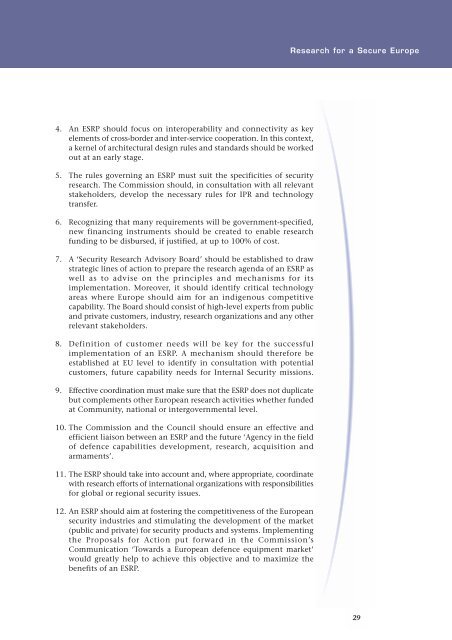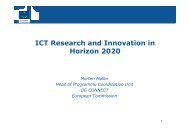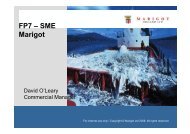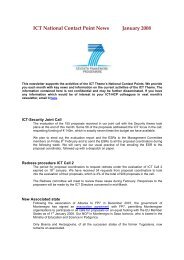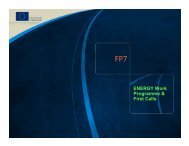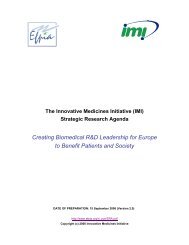Research for a Secure Europe - European Commission - Europa
Research for a Secure Europe - European Commission - Europa
Research for a Secure Europe - European Commission - Europa
You also want an ePaper? Increase the reach of your titles
YUMPU automatically turns print PDFs into web optimized ePapers that Google loves.
<strong>Research</strong> <strong>for</strong> a <strong>Secure</strong> <strong>Europe</strong><br />
4. An ESRP should focus on interoperability and connectivity as key<br />
elements of cross-border and inter-service cooperation. In this context,<br />
a kernel of architectural design rules and standards should be worked<br />
out at an early stage.<br />
5. The rules governing an ESRP must suit the specificities of security<br />
research. The <strong>Commission</strong> should, in consultation with all relevant<br />
stakeholders, develop the necessary rules <strong>for</strong> IPR and technology<br />
transfer.<br />
6. Recognizing that many requirements will be government-specified,<br />
new financing instruments should be created to enable research<br />
funding to be disbursed, if justified, at up to 100% of cost.<br />
7. A ‘Security <strong>Research</strong> Advisory Board’ should be established to draw<br />
strategic lines of action to prepare the research agenda of an ESRP as<br />
well as to advise on the principles and mechanisms <strong>for</strong> its<br />
implementation. Moreover, it should identify critical technology<br />
areas where <strong>Europe</strong> should aim <strong>for</strong> an indigenous competitive<br />
capability. The Board should consist of high-level experts from public<br />
and private customers, industry, research organizations and any other<br />
relevant stakeholders.<br />
8. Definition of customer needs will be key <strong>for</strong> the successful<br />
implementation of an ESRP. A mechanism should there<strong>for</strong>e be<br />
established at EU level to identify in consultation with potential<br />
customers, future capability needs <strong>for</strong> Internal Security missions.<br />
9. Effective coordination must make sure that the ESRP does not duplicate<br />
but complements other <strong>Europe</strong>an research activities whether funded<br />
at Community, national or intergovernmental level.<br />
10. The <strong>Commission</strong> and the Council should ensure an effective and<br />
efficient liaison between an ESRP and the future ‘Agency in the field<br />
of defence capabilities development, research, acquisition and<br />
armaments’.<br />
11. The ESRP should take into account and, where appropriate, coordinate<br />
with research ef<strong>for</strong>ts of international organizations with responsibilities<br />
<strong>for</strong> global or regional security issues.<br />
12. An ESRP should aim at fostering the competitiveness of the <strong>Europe</strong>an<br />
security industries and stimulating the development of the market<br />
(public and private) <strong>for</strong> security products and systems. Implementing<br />
the Proposals <strong>for</strong> Action put <strong>for</strong>ward in the <strong>Commission</strong>’s<br />
Communication ‘Towards a <strong>Europe</strong>an defence equipment market’<br />
would greatly help to achieve this objective and to maximize the<br />
benefits of an ESRP.<br />
29


